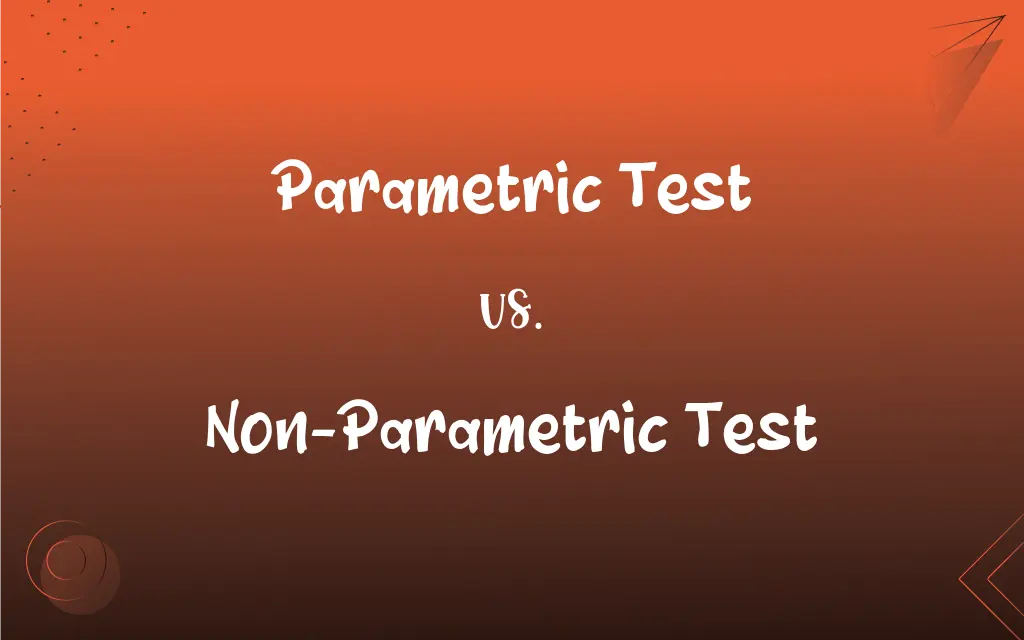Parametric Test vs. Non-Parametric Test: What's the Difference?
Edited by Aimie Carlson || By Janet White || Published on February 25, 2024
Parametric Test is a statistical test assuming data follows a known distribution, typically normal. Non-Parametric Test is a statistical test that does not assume a specific distribution for the data.

Key Differences
Parametric tests rely on assumptions about the data’s distribution, often requiring a normal distribution. Non-parametric tests, however, do not require data to follow any specific distribution, making them more flexible with different types of data.
In parametric tests, parameters like mean and standard deviation are crucial, as they assume a specific form for the distribution. Non-parametric tests are distribution-free and often used when data does not meet the assumptions necessary for parametric tests.
Parametric tests are typically more powerful if their assumptions are met, meaning they are more likely to detect a true effect. Non-parametric tests, while less powerful, are more robust against outliers and skewed data distributions.
The use of parametric tests is common in situations with large sample sizes and well-understood distributions. Non-parametric tests are preferred in smaller samples or with ordinal data, where distribution assumptions cannot be safely made.
Examples of parametric tests include the t-test and ANOVA, which compare means between groups. Non-parametric counterparts include the Mann-Whitney U test and Kruskal-Wallis test, which compare medians or ranks.
ADVERTISEMENT
Comparison Chart
Data Distribution
Assumes specific distribution (often normal)
Does not assume specific distribution
Sample Size
Generally requires larger samples
Suitable for smaller samples
Sensitivity
More powerful if assumptions are met
Less powerful but more robust
Data Requirements
Relies on interval or ratio data
Can be used with ordinal or nominal data
Statistical Parameters
Uses parameters like mean and standard deviation
Does not rely on specific statistical parameters
ADVERTISEMENT
Parametric Test and Non-Parametric Test Definitions
Parametric Test
Suitable for hypothesis testing with large sample sizes.
For large datasets, a parametric test such as ANOVA is often preferred.
Non-Parametric Test
Used when parametric test assumptions are not met.
Due to small sample size, a non-parametric test was chosen.
Parametric Test
Assumes homogeneity of variance in the data.
The parametric test indicated significant differences between the groups.
Non-Parametric Test
Suitable for ordinal or nominal data.
Non-parametric tests are ideal for analyzing ranked data.
Parametric Test
Often used when data distribution is well-understood.
Parametric tests were chosen due to the normal distribution of the data.
Non-Parametric Test
A test that does not require data to follow a specific distribution.
The Mann-Whitney U test, a non-parametric test, was used for skewed data.
Parametric Test
A test based on assumptions about a population’s distribution.
The t-test, a parametric test, was used to compare the means of two groups.
Non-Parametric Test
Does not rely on mean or standard deviation.
Non-parametric tests were used due to the absence of a clear mean.
Parametric Test
Relies on specific statistical parameters like mean.
In a parametric test, the normality of data distribution is often assumed.
Non-Parametric Test
Robust against outliers and non-normal distributions.
The non-parametric test showed significant results despite outliers.
FAQs
What is a parametric test?
A statistical test based on assumptions about the data’s normal distribution.
When should I use a parametric test?
When your data is normally distributed and meets other test assumptions.
Can I use a non-parametric test for ordinal data?
Yes, non-parametric tests are suitable for ordinal data.
What defines a non-parametric test?
It's a statistical test that does not assume a specific distribution for data.
Are non-parametric tests less powerful?
They can be less powerful but are more robust in certain conditions.
What are examples of non-parametric tests?
Examples include the Mann-Whitney U test and the Kruskal-Wallis test.
Do parametric tests require larger sample sizes?
Generally, they are more reliable with larger samples.
Can I use a non-parametric test with interval data?
Yes, but it might be less informative than a parametric test.
How do I know if my data is normally distributed?
You can use statistical tests like the Shapiro-Wilk test to check normality.
What are examples of parametric tests?
Examples include t-tests, ANOVA, and linear regression.
What is the benefit of using a non-parametric test?
They are useful when data doesn't meet the assumptions of parametric tests.
How does sample size affect test choice?
Smaller samples often necessitate non-parametric tests.
Can parametric tests be used on ranked data?
It's possible, but non-parametric tests are generally more suitable for ranked data.
Are non-parametric tests easier to compute?
They can be simpler to compute as they require fewer assumptions.
Are parametric tests more accurate than non-parametric tests?
Accuracy depends on meeting the underlying assumptions of the test.
Can I use both types of tests on the same data?
Yes, but it's important to understand the implications of each.
Do parametric tests assume equal variances?
Many parametric tests do assume homogeneity of variance.
Can non-parametric tests be used for hypothesis testing?
Yes, they are often used for hypothesis testing when data doesn't meet parametric assumptions.
What is the main limitation of parametric tests?
They require assumptions about the data's distribution.
What if my data violates normality assumptions?
A non-parametric test would be more appropriate in this case.
About Author
Written by
Janet WhiteJanet White has been an esteemed writer and blogger for Difference Wiki. Holding a Master's degree in Science and Medical Journalism from the prestigious Boston University, she has consistently demonstrated her expertise and passion for her field. When she's not immersed in her work, Janet relishes her time exercising, delving into a good book, and cherishing moments with friends and family.
Edited by
Aimie CarlsonAimie Carlson, holding a master's degree in English literature, is a fervent English language enthusiast. She lends her writing talents to Difference Wiki, a prominent website that specializes in comparisons, offering readers insightful analyses that both captivate and inform.







































































